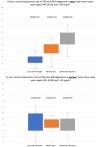Epidemiology, management and patient needs in myasthenia gravis: an Italian multistakeholder consensus based on Delphi methodology
- PMID: 39806659
- PMCID: PMC11667248
- DOI: 10.1136/bmjopen-2024-086225
Epidemiology, management and patient needs in myasthenia gravis: an Italian multistakeholder consensus based on Delphi methodology
Abstract
Objectives: To provide comprehensive information on the burden of myasthenia gravis (MG) in Italy, including the unmet needs of patients and several other aspects related to the disease, based on skilled viewpoints of MG experts.
Design: Iterative analysis conducted in accordance with the best practices of the Delphi method, including anonymity, controlled feedback, and statistical stability of consensus.
Setting and participants: 24 clinicians, 18 public health experts and 4 patient associations experts completed all the Delphi iterations between 18 April and 3 July 2023, for a total of 46 participants from several Italian Regions.
Outcome measures: Five areas of investigation related to MG were examined: epidemiology in Italy and characteristics of disease; diagnostic issues and Italian patient journey; unmet needs during the acute and chronic phases of MG; quality of life; public health management of MG. Consensus in the Delphi iterations was defined by both the percentage level of agreement between panellists or the median value of the responses.
Results: We reported a high level of agreement (ie, >66.7% of panellists) on the prevalence and incidence of disease in Italy and on several management issues. A strong impact of MG on the quality of life of patients also emerged. Cross-agreement was achieved among different subgroups of panellists (ie, clinicians, public health experts and patient associations representatives) for most items proposed.
Conclusions: This study provided guidance for educational and practical aspects of MG in Italy, highlighted disease severity and its role on patients' quality of life. A few gaps related to the handling of MG in Italy also emerged.
Keywords: EPIDEMIOLOGY; Neuromuscular disease; Quality of Life.
© Author(s) (or their employer(s)) 2024. Re-use permitted under CC BY-NC. No commercial re-use. See rights and permissions. Published by BMJ.
Conflict of interest statement
Competing interests: All authors have completed the ICMJE uniform disclosure at http://www.icmje.org/disclosure-of-interest/ and declare FH has received consulting fees, payment or honoraria for lectures, presentations, speakers bureaus, manuscript writing or educational events and support for attending meetings and/or travel from UCB, Alexion, Argenx, Roche, Alfa Sigma and Boehringer Ingelheim; RI has received MgNet Pilot Award 2022/2023; has received consulting fees, payment or honoraria for lectures, presentations, speakers bureaus, manuscript writing or educational events from UCB, Alexion, Argenx and Dianthus Therapeutics; has participated on a Data Safety Monitoring Board or Advisory Board for Alexion and Argenx; MU has received financial support for the submitted work from UCB, payments were made to her Institution; has received consulting fees, payment or honoraria for lectures, presentations, speakers bureaus, manuscript writing or educational events from UCB and Alexion, payments were made to her Institution; has received support for attending meetings and/or travel from UCB, Alexion and Argenx, supports were facilitated through her Institution; RM has received consulting fees from UCB and Alexion; has received payment or honoraria for lectures, presentations, speakers bureaus, manuscript writing or educational events from Eleuthera and Argenx; has participated on a Data Safety Monitoring Board or Advisory Board for Merck, UCB and Alexion; is the President of the Italian Myasthenia Gravis Association; GA, GL, CG and PM declare no support from any organisation for the submitted work; no financial relationships with any organisations that might have an interest in the submitted work in the previous three years; no other relationships or activities that could appear to have influenced the submitted work.
Figures



References
MeSH terms
LinkOut - more resources
Full Text Sources
Medical
Miscellaneous
